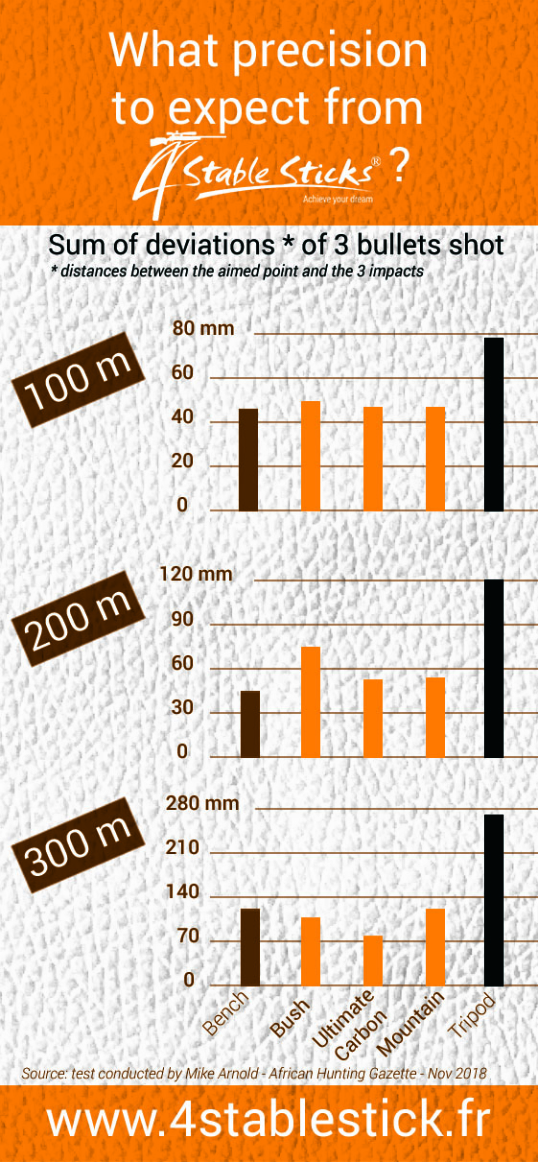Ecrit par Mike Arnold
Introduction
I was very dubious. That’s the only word to describe my internal response when my Blaauwkrantz Safaris PH, Arnold Claassen, arrived with his newest purchase. He pulled his new gun-rest out of the packaging and explained that it would give me a stable platform from which to shoot a Grey (Bush) Duiker, an animal that would be fortunate to achieve 50 cm of shoulder height and a weight of 18 kg (http://www.krugerpark.co.za/africa_common_duiker.html). Though I gave forth with an enthusiastic, “Great!”, I was actually brimming over with unspoken doubts.
Looking at his ‘Bush Stick’ model from 4 Stable Stick®, I made a single observation, there were only two points of contact with the ground; my deluxe tripod, as expected, had three. My first thought was “How can this possibly lead to less wobble than my ‘sticks’.”
My second thought was “I am in serious trouble.”
What I did not appreciate from my cursory examination of Arnold’s new client-help was the fact that my stock would be cradled back and front. I should have made the connection with an earlier conversation between an experienced African hand and myself at my shooting club back in the States, but I did not. Phil had approached me at the range when I was practicing with my tripod. He asked what I thought of the rest. I told him that I could not keep my rifle from having a significant horizontal wobble. So, rather than just aiming and letting off the shot, I was being forced to time my shots when the sight pattern wobbled to the correct point-of-aim. Needless to say, I was not happy with my accuracy. He told me that the key was to have something to stabilize your rear arm (that grasped the pistol grip and trigger) and thus the butt of the stock. One PH of his had accomplished this stability for his clients by allowing them to rest their rear elbow on his shoulder. I wish I had remembered this conversation before we went after my Grey Duiker, because I might have been a bit more confident and thereby enjoyed the hunt.
I think I should make one more observation before I move on to the conclusion of my Duiker hunt, and then to the Range Comparison of my tripod and the two, 4 Stable Stick® models. Videos and books that discuss African hunting emphasize the need to become proficient (read, ‘accurate’) with tripod rests because that is what the hunter will be using during his/her Safari. Unfortunately, regardless of what is written (or depicted on film), few of us normal, runof-the-mill hunters will find a tripod to be as stable as suggested by professional writers and those appearing on TV hunting series. Whatever the reason (most likely actual differences in the proficiency of professionals versus non-professionals!) many hunters, using tripod rests, are unable to achieve the accuracy necessary for field shooting unless provided additional stabilization (for example, as given by the PH of my friend). Using myself as an example, I practiced once a week, firing 20-30 rounds from my 7mm Remington Magnum and 10-15 rounds from my .35 Whelen Improved. Once my rifles were sighted-in, I fired only from my tripod, but I eventually resorted to shooting only at 100 yds due to my lack of accuracy at 200-300 yds.
What is the catalyst for the following range test? That brings us back to my hunt for a Grey Duiker. As I said, I had never fired a shot from Arnold’s, Bush Stick rest. So, when the pygmy antelope charged out of the incredibly thick Eastern Cape brush – drawn out by Arnold’s work on his varmint call – I was amazed at how there was absolutely no wobble as I tilted the rifle and rest to sight down the slope at the little male that would earn a Safari Club International ‘Gold’ award. My whispered, “What is the range?”, was answered immediately by Arnold’s, “Shoot him!” I finished the trigger pull and the little animal folded. Right after my shot, Arnold informed me that his rangefinder had registered 107 yds. This was not a long distance, to be sure, but remembering a shoulder height of approximately 50 cm and a weight of less than 18 kg, the shot should have been quite difficult for me. I was thoughtful as we headed down the slope. This was the final animal of my Safari, so my experience left me wondering whether or not it had been a stroke of luck that the Bush Stick had given me such a steady rest. That is the catalyst for the following range trial involving a comparison of a beautifully-made tripod with the 4 Stable Stick®, Bush Stick and Mountain Stick.
Materials and Methods
The rifles used in this range test were a Model 700 Remington in 7mm Remington Magnum and a Custom-built rifle in the wildcat cartridge, .35 Whelen Improved. The ammunition for both firearms were handloaded by the author. For the 7mm, IMR 4350 powder and 175-grain Nosler Partition bullets were used, obtaining a [chronographed] velocity of 2800 fps. For the 35-caliber, IMR 4064 powder and 250-grain Nosler Partition bullets were used, obtaining a [chronographed] velocity of 2400 fps.
A total of 72 and 48 cartridges were fired using the 7mm Remington Magnum and .35 Whelen Improved, respectively. Five shooting sessions (on separate days) were used in this analysis. Three shots were fired from each type of rest (bench, tripod, Mountain Stick [seated position] and Bush Stick [standing position]), at each of the distances; 100, 200 and 300 yds(91.44, 182.88 and 274.32 meters, respectively) for the 7mm and 100 and 200 yds (91.44 and 182.88 meters, respectively) for the .35 Whelen Improved. In order to better simulate hunting conditions, each of the three shot groups was fired quickly (all shots fired within approximately 45 seconds), forcing the repeated and rapid acquisition of the target. This resulted in larger group sizes than have been achieved by using more deliberate firing (data not shown). After each session, the greatest spacing between shots within each group (for each of the combinations of distance and type of rest), were recorded. Once all range work was completed, these data were used to calculate the mean greatest distance for each of the caliber/distance/rest combinations.
I purchased the tripod utilized in this analysis from a leading manufacturer of African hunting gear and clothing. As stated before, the ‘Bush Stick’ was purchased from 4 Stable Stick® (62 Allée des peupliers, 33000 Bordeaux, France; website: https://4stablestick.fr/gb/11-4stable-stick; Phone: +33684821251). The ‘Mountain Stick’ was sent to me by 4 Stable Stick® for inclusion in my analysis. All products were used as directed by their manufacturers, and all were in excellent condition.
Still photos were used to document the various stages of the study.
Results and Discussion
Results from both the 35 and 7mm calibers were consistent with regard to the accuracy obtained by each of the
various rests. The tripod was the most inaccurate rest type by a large margin (see Bar Graphs). Means of the 3-shot group sizes, for each of the other three rest types were similar with the bench producing slightly larger or smaller groups for some range/caliber combinations than either the Mountain or Bush Stick. These latter two rest types yielded nearly identical results; the smallest group sizes were obtained in all of the caliber/distance combinations using either the Mountain Stick, Bush Stick or bench.
In terms of the rest types that yielded the most-to-least accurate shooting, the order was Mountain Stick=Bush Stick ≥ Bench >>> Tripod. It may seem surprising that the group sizes from the bench, particularly in the trials involving the .35 Whelen Improved, sometimes exceeded those of both the Mountain Stick and Bush Stick. However, the bench rest did not involve the securing of the butt portion of the rifle. Thus, though much more secure than the tripod, the bench rest sometimes lacked the steadiness afforded by both of the 4 Stable Stick® products. Ironically, the bench was intended as the ‘control’ rest type that was expected to produce the smallest group sizes. Instead, it provided an important indicator of why the Mountain and Bush Sticks gave such improved accuracy – it was due to the securing of both the for-end and butt of the firearms.
The inaccuracy of the tripod rest was caused by the instability of the butt portion of the rifle. However, this reflects a positive aspect of this rest type; the tripod allows rapid, horizontal realignment of the sights on a moving animal. It is more difficult to horizontally realign the rifle using either of the 4 Stable Stick® products, without lifting the entire unit. In contrast, vertical realignment with the Mountain Stick and Bush Stick is instantaneous, requiring the shooter to simply lean backward or forward; an equally steady shooting platform is obtained through the entire range of motion.
Though equivalent accuracy was obtained from the Mountain Stick and Bush Stick, the former model allows the user to shoot from a variety of positions – kneeling, sitting and standing. Thus, this model can be used as a standing rest when stalking, but can be quickly reduced in height to allow the hunter to fire from a sitting or kneeling position. Furthermore, the telescopic legs allow firing from slopes when hunting in mountainous terrain.
A very significant aspect of the three rest types is that all are rigid enough to be used as walking sticks. In this regard, though both the 4 Stable Stick® products will likely be lighter than most tripod rests, the difference in weight is unlikely to be great enough to cause increased fatigue for the user.
Finally, all of the rest types can be reduced in size for travelling in a hard-sided gun case. However, the Mountain Stick is the most straightforward in this regard because its telescoping legs allow quick reduction in size with no disassembly required. In contrast, both the Bush Stick and tripod must be broken down into component parts
for transport and then reassembled on arrival in the hunting camp.
Conclusions
The results of this analysis are clear. If a hunter wishes to have the greatest accuracy, they should utilize a rest that secures both the for-end and butt of their firearm; both the 4 Stable Stick® Mountain Stick and Bush Stick provide this design. This stability did come at the cost of reduced horizontal mobility. However, most hunters (and their guides/PHs) will not be comfortable with shots taken at moving animals, so this limitation may be less of an issue than first appears. Furthermore, the significantly improved accuracy over tripod rests, for both calibers and at all distances, suggests that it will be much more ethical for hunters such as myself to use products like the Bush Stick or Mountain Stick.
The flexibility provided by the Mountain Stick, in terms of shooting positions, argues for its inclusion in most shooting and hunting applications. Because of the findings from this analysis, I will be using the Mountain Stick over the next several months while preparing for another African Safari, and it will travel with me to Africa as an essential piece of equipment.

